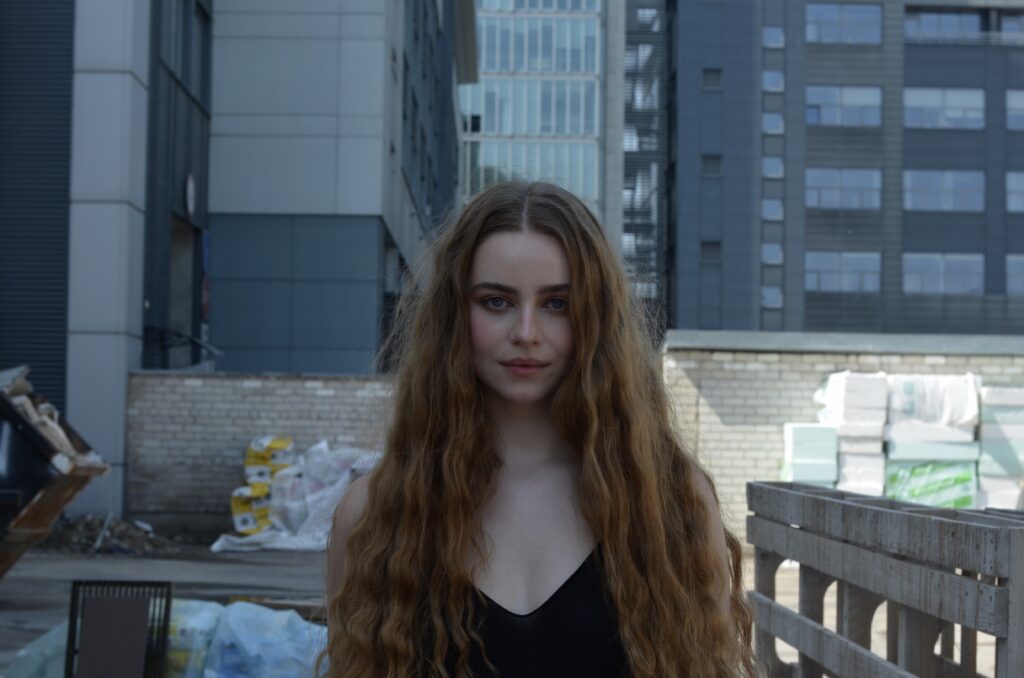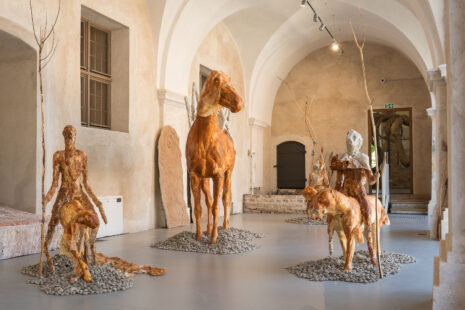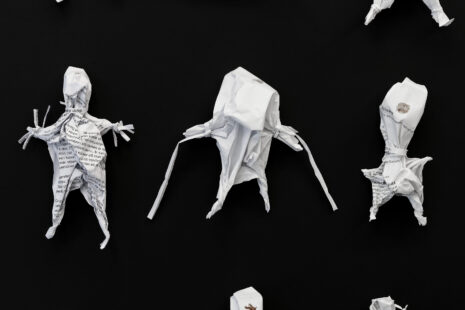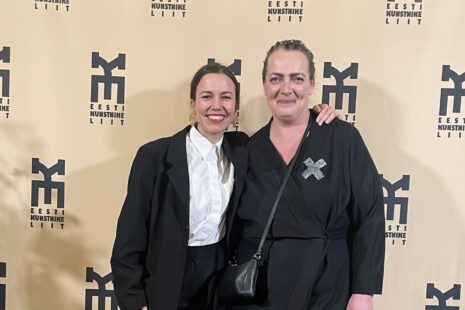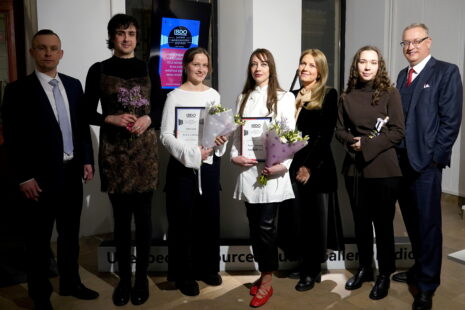Congratulations on winning the Grand Prix of NOBA Award! How does it feel? Did you expect that?
Thank you! It’s always an excellent feeling when people trust your ideas and appreciate your work; it gives the strength to move on. It was very unexpected for me- I signed up without considerable expectations because competing among five art academies is difficult; it’s a big challenge. So, to have my work singled out among such strong artists is a special event and achievement for me.
You entered three paintings into the competition that were also part of your academy theses. Please talk a bit about these large-scale mixed works. What is the story behind these?
The three works are part of a large cycle I completed during my Master’s research. Each work has an extensive and different background, but they all share a common theme and method:
My creative strategy is based on the concept of acousmaticity (meaning sound without a visible source), which is mainly used in the music field. However, I have been exploring it in the context of visual arts since 2020. It refers to the phenomenon of sound, the manipulation of physiological reactions. Still, in my work, it gives a directly or topically invisible (or virtual) expression. Through this conceptual model, the work’s narrative is concealed, leaving only the consequence of the visual part in the viewer’s eye, but complemented by the unknown, the unexpected, transcendental contents and themes. In this way, I have tried to bring my medium (painting) to a new level, extending painting to other disciplines and giving it the expressiveness, instability, performativity, and objectivity of different media. In this way, I have given weight to painting by rejecting the modernist theory of the purity of the medium and have sought to extend it into space to give it an interactive dimension.
For example, the work “Butterfly Effect + Lapis Lazuli” perfectly demonstrates all these levels of knowledge applied to a work of art.
It only opens when the viewer is in front of it, in other words, when they touch its sensors. The motion sensor switches on the chip in the picture: sound and movement are produced. The inner part of the painting, which emerges slowly, reveals a different form with each passing minute; thanks to its unique position in time, the painting unfolds in all its phases. Finally, for the curious viewer, it also shows its essence – lapis lazuli’s pigment, the rarest blue pigment in the world, making it a sacred, unique experience. The viewer becomes the protagonist, placing the butterfly effect as a symbol of the fact that each interpretation determines the future and the change in time of the work of art. This reveals my method of acousmaticity, which directs the whole experience to the viewer, not by showing him his context but only by showing what the viewer brings with him and his central role in the creation of the work.
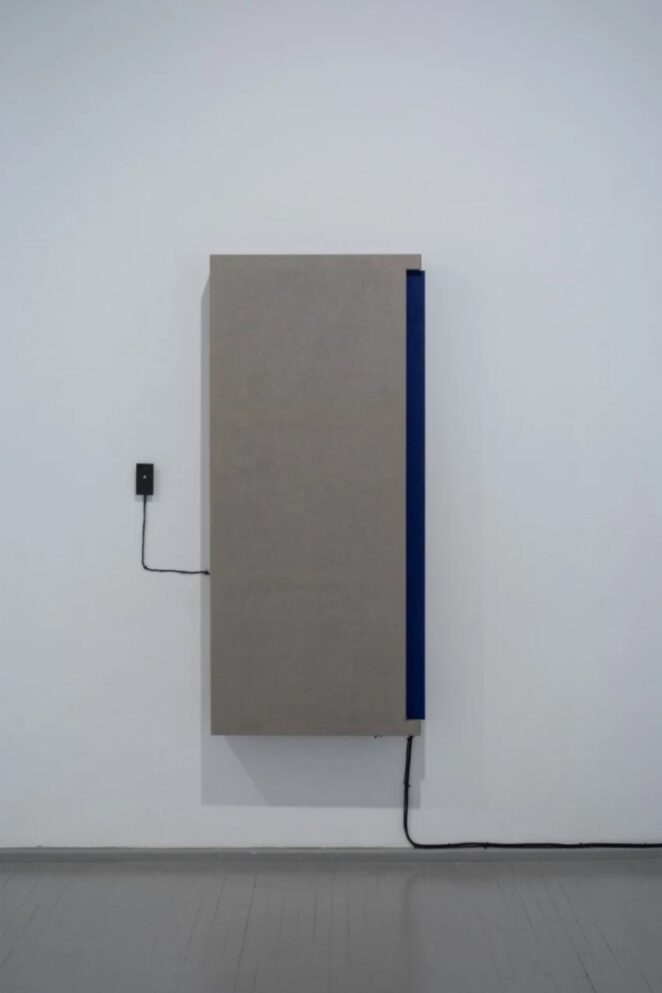
BUTTERFLY EFFECT + LAPIS LAZULI, 2023
by Agata Orlovska
You also won the Young Painter’s Prize last month. The award includes an art residency option for 2 months in Norway at the Nordic Artists Centre Dale and an opportunity to host a solo show in Pamėnkalnio Gallery, Vilnius. It seems like you have next year planned out already.
Indeed, the coming year is set to be an intense one. Along with the achievements came responsibilities and expectations; it is a good incentive not to stop and rest on one’s laurels.
I am very happy about these big plans for the coming year because having a goal always makes the work process more clear. I am already selecting new works that will fit into the gallery’s dimensions, the overall theme, and the desired visual and exhibition atmosphere. For the first time, I will be going abroad for a residency. For the first time, I will have so much time to plan the exhibition in detail for a specific space, which gives me the freedom to create, the comfort for new works to appear, and the strength of my position as an artist. I’m excited about the following year, I’m just burning with creativity at these moments.
You finished your studies in Vinius Art Academy this year, right? So, what are the projects you are working on now?
Correct, I finished my MA in Painting in the summer and now work in my studio in Vilnius. I am currently researching the same topic of the quality of acousmaticity in visual art, and I am finding its new paths and profound possibilities for my PhD studies, which I am planning for in the future. However, unlike during my studies, I am now creating more installation, object, kinetic, interactive and sound art. I started with painting, but I don’t have a solid conviction to stay in it because the themes that interest me belong to interdisciplinary art. I allow myself to experiment and search for new materials and collaborations, which gives me a pleasant feeling of the unknown and new discoveries, which motivates me for new works.
You have attended at least two international competitions successfully this year – if and why would you recommend this experience to other young talents?
Of course, the artist, in general, in my opinion, has to be present everywhere. But not for the sake of winning or competing but for the excellent opportunity to see oneself in the broader field of art. Competitions reveal the artist’s uniqueness, his/her own identity and the direction he/she wants to move in. International competitions are an excellent opportunity to feel the broader market, what place you have in it, what effect you leave on your audience, how you are read and whether you are generally understood. Apart from winning, it’s also about visibility, and often, art galleries, projects or buyers become interested in young artists after such competitions.
It also builds the courage to be seen, appreciated, and criticised.
In other words, it builds up the artist’s psychological muscle and strength before entering the large art market, which is not always friendly and accessible.
When looking at the works of your competition at Nordic & Baltic Young Artist Award, was there anything that stood out or surprised you?
There were undoubtedly many substantial works and many outstanding young talents. But I was pleasantly surprised by Strangers at the Abyss, 2023 by Arvid Staaf. Even though I have a very conceptual approach to my work, I liked the freedom of the work and the way it allows the creativity to take unexpected forms, from set design to object art, to installation. Also, my absolute favourite was Nimeämätön (Left Without a Title), 2023 by Hermanni Härmälä. The artist takes a very unexpected approach to the image on the canvas, letting it create/destroy in the sun, touching on severe philosophical themes of time and the critique of institutions. It was a solid undergraduate show, in my opinion.
You are also known for objects and sound installations. Tell me more about that. What kind of sound installations do you work on?
As I mentioned before, I use the methodology of acousmaticity. So, the method itself proposes the use of sound, which is about the degree of relationship between sound and image and its reflection in the conceptual plane. I create sound in conjunction with the theme of the installations I’m creating, supplementing the visual with sound and sound with the visual. Sound is mainly controlled by touch; it only appears when the viewer is in front of the work. I use microchip manipulation, so the sound level rises and falls depending on the viewer’s distance and the pace of movement, so there is no constancy. These installations are closely related to exploring the viewer’s position through the prism of acousmaticity and highlight the importance and authenticity of the viewer. These installations are not gifts to the viewer; on the contrary, they manipulate, provoke and unmask the viewer, leaving him or her confronted with the inevitability of interpretation.
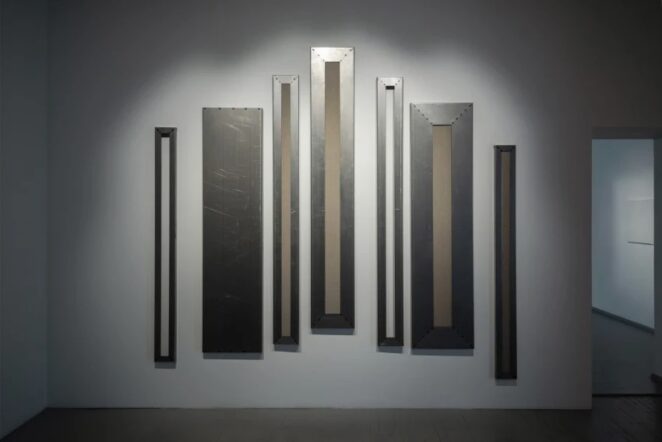
“Perseve My Language Forever” by Agata Orlovska.
How is it to work in such different fields – sound and painting? And you have taken part in quite a few group exhibitions. Can you share tricks with other young artists about being active and productive?
I have had many questions asking me to define myself. So am I parting with painting, or am I giving up interdisciplinarity? I don’t see much drama in it because I don’t see painting itself as something strictly remaining in its symbolic “frame”.
For me, painting is spatial, objective, and performative. So, I don’t feel a big difference between my installations and my paintings; for me, it’s the same.
Because my priority has always been art – its idea and concept, the means of expression is just a tool for me. I change it whenever I feel that the idea requires another form.
My recipe for productivity is constantly maintaining the drive, which comes with newness. Every job is a new challenge for me, for which I have to learn new things and often push myself and become more professional, so I am not afraid of challenging myself and venturing into the unknown. I am also interested in and love all kinds of art, cinema, theatre, and music – following culture in the general sense is a must for an artist. The cultural context of the eyes determines everything. If they are full and rich, they always have unexpected solutions to their art. The mind is not always able to conceptualise solutions, but the unexpected solutions that happen in the brain are due to the rich context of the eye.
What are the following exhibitions where people can see your work?
I have a few small group shows with local artists scheduled for spring/summer. I will also show my work in a group show in Denmark at galleri NB in the summer. In autumn, I will open my solo exhibition at the Pamenkalnio Gallery in Vilnius, the dates of which will coincide with the announcement of the winner of the Young Painter Prize.

